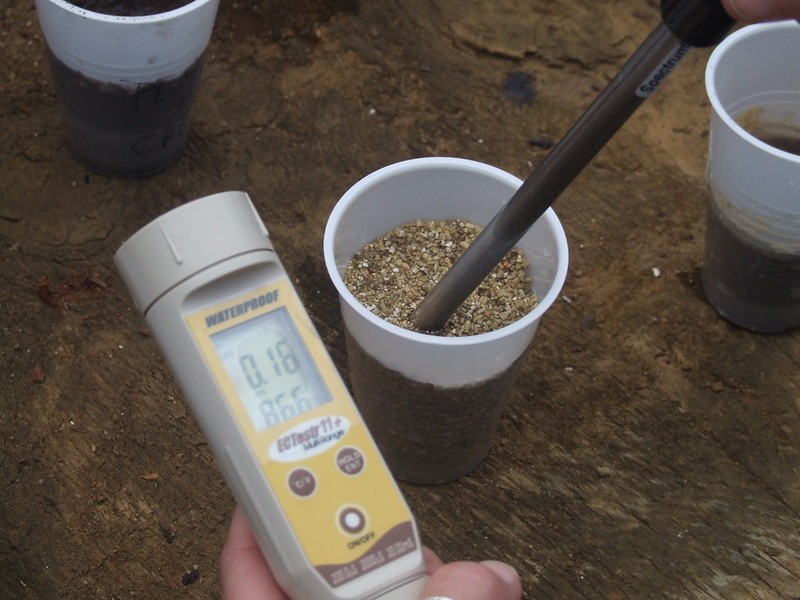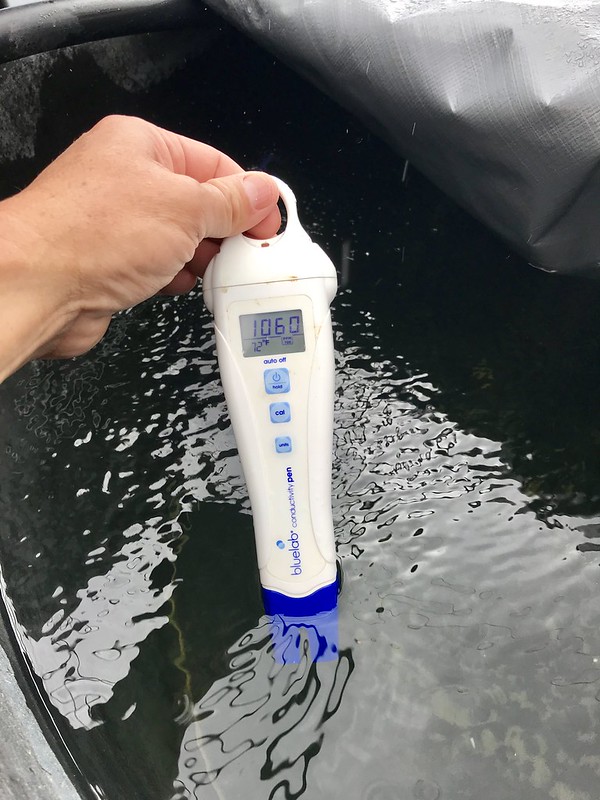
How to Choose the Right EC Meter for Your Hydroponic System
Welcome, seasoned growers! This guide dives deep into the world of EC meters, your essential tool for unlocking next-level hydroponic success. By mastering optimal EC levels, you’ll fine-tune nutrient delivery, optimize plant performance, and maximize yields. Buckle up as we explore advanced techniques, learn how to read an EC meter, and explore the top EC meters on the market, including those ideal for hydroponics and those integrating pH and EC measurements.
EC: The Key to Nutrient Harmony.
Imagine an EC meter as the orchestra conductor, directing the flow of essential nutrients to your plants. It measures electrical conductivity in your nutrient solution, directly impacting nutrient availability. Understanding optimal EC levels for different crops and growth stages is crucial, making an EC meter for hydroponics indispensable. Here’s a quick guide:
- Vegetative stage: Aim for 1.2-2.0 mS/cm, allowing for robust root development.
- Fruiting stage: Up the ante to 2.5-3.5 mS/cm to fuel explosive yield.
- Remember: EC, alongside pH (5.5-6.5) and temperature (18-22°C), plays a critical role.

Why Precise EC Measurement Matters.
Hitting the sweet spot with EC meters prevents both under-fertilization (starving your plants) and over-fertilization (leading to toxicity). This precision translates to:
- Boosted yields: Tailored EC levels, understood through how to read an EC meter, unlock the full potential of your crops.
- Reduced waste: Avoid nutrient runoff, protecting the environment and saving money.
- Happy plants: Optimal EC levels mean thriving plants with vibrant growth and resilience.
Exploring the EC Meter Universe.
Finding the perfect EC meter, be it a TDS EC meter or an EC pH meter, is like choosing your hydroponic sidekick. Here’s a breakdown of the main types:
- Portable handheld meters: Compact, accurate, and ideal for quick on-the-go checks.
- In-line sensors: Continuously monitor your nutrient solution, perfect for automated systems.
- Benchtop meters: Lab-grade precision for research and developing custom nutrient blends.
- Wireless meters: Monitor EC remotely, ideal for large-scale operations.
- Smart probes: Direct readings in soil or nutrient solution, perfect for soil-based hydroponics.
- Multiparameter meters: Measure multiple factors like EC, pH, and temperature for a holistic view.
Top Picks for Advanced Growers:
- HydroPro EC Smart Sensor: Cloud-based data, precision monitoring, and automated adjustments.
- AquaLab Multi-Parameter Analyzer: In-depth analysis with EC, pH, and more, for research and commercial applications.
- EcoGrow Inline EC Monitor: Real-time nutrient management for large-scale hydroponics setups.
- GrowDirector EC & Water Temperature Sensor: Direct soil readings, ideal for soil-based agriculture.

Consider these factors when selecting your EC meter:
- Accuracy and calibration: Choose reliable accuracy with simple calibration processes.
- Data logging and connectivity: Track trends and make informed decisions with data logging and analysis tools.
- Durability: Opt for meters that withstand the demands of your hydroponic environment.
How to read EC meter?
Before You Start:
- Identify your meter type: Different types of EC meters might have slightly different features and procedures. Knowing your specific model helps ensure accurate readings.
- Prepare your calibration solutions: Most EC meters require regular calibration.Consult your meter’s manual for the recommended solutions and calibration procedure.

Taking a Reading:
- Turn on your meter: Follow your meter’s instructions for powering it on.
- Prepare the sample: Depending on your setup, you might need to collect a sample of your nutrient solution in a clean container. For soil-based hydroponics,some meters allow direct measurement in the soil.
- Immerse the probe: Dip the probe of your meter into the sample, ensuring it’s fully submerged and doesn’t touch the container sides or bottom.
- Wait for stabilization: Most meters automatically stabilize and display the reading once the measurement is complete. This usually takes a few seconds.
- How to read EC meter: Note down the displayed EC value in microsiemens per centimeter (μS/cm) or millisiemens per centimeter (mS/cm). Some meters might display parts per million (ppm), but consult your manual for the conversion factor specific to your solution.
Interpreting the Reading:
- Compare to optimal ranges: Optimal EC levels vary depending on your crop,growth stage, and specific nutrient solution. Consult a reliable source for recommended ranges for your specific situation.
- Consider additional factors: While EC is a valuable tool, factors like pH and temperature also impact nutrient availability. Monitor and adjust these parameters as needed.
Additional Tips:
- Rinse the probe: After each use, rinse the probe with clean water and dry it gently to prevent contamination and maintain accuracy.
- Calibrate regularly: Follow your meter’s recommended calibration frequency to ensure reliable readings.
- Store properly: When not in use, store your meter according to the manufacturer’s instructions to protect it from damage and maintain its lifespan.
Maintaining Your EC Meter Ally:
What is the lifespan of an EC meter? Lifespan: 5-10 years with proper care.
Regular care ensures your meter provides accurate readings for years to come. Here’s how:
- Calibrate regularly: Use standard solutions to maintain accuracy.
- Clean electrodes: Rinse with distilled water after each use.
- Store properly: Follow manufacturer recommendations for electrode storage.
Electrical Conductivity Ranges for Common Crops:
While we’ve provided some general ranges, remember, experienced growers fine-tune EC based on specific crop needs, variety, and even environmental factors. Don’t be afraid to experiment and observe your plants’ responses!
| Crop | Vegetative Stage | Flowering/Fruiting Stage |
| Lettuce | 1.0 – 1.8 | 1.5 – 2.5 |
| Spinach | 1.2 – 2.0 | 1.8 – 3.0 |
| Kale | 1.5 – 2.5 | 2.0 – 3.2 |
| Tomato | 1.8 – 2.5 | 2.2 – 3.0 |
| Pepper | 1.5 – 2.3 | 2.0 – 2.8 |
| Cucumber | 1.8 – 2.5 | 2.2 – 3.0 |
| Strawberry | 1.3 – 2.0 | 1.5 – 2.5 |
| Basil | 1.2 – 2.0 | 1.8 – 2.5 |
| Mint | 1.5 – 2.2 | 2.0 – 2.8 |
| Cannabis | 1.2 – 2.0 (Seedling) | 1.6 – 2.4 (Vegetative) |
How does high EC affect plants?
High EC effects: Can lead to osmotic stress and stunted growth. Monitor and adjust EC levels accordingly.
What is the difference EC vs. TDS: Demystifying the Difference.
Understanding both is key for advanced nutrient management:
- EC: Measures total ionic activity directly, offering a precise picture of nutrient availability.
- TDS: Estimates total dissolved solids based on EC, but accuracy can vary depending on the conversion factor.
EC reigns supreme for hydroponics due to its directness and accuracy. However, TDS meters can be useful for quick checks or less critical situations.
Embrace the Power of Electrical Conductivity:
By mastering EC management, you unlock the full potential of your hydroponic system. With the right knowledge, tools, and practices, including understanding the nuances of electrical conductivity, how to read an EC meter, and selecting the best EC meter for hydroponics, you’ll cultivate thriving plants and witness harvests that will leave you smiling (and maybe a little surprised!).
More resources about sensors: